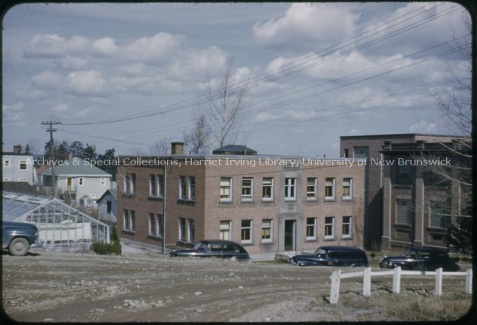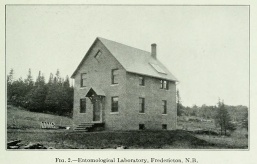Institute of Biomedical Engineering: Difference between revisions
Markmcumber (talk | contribs) No edit summary |
mNo edit summary |
||
| (6 intermediate revisions by 3 users not shown) | |||
| Line 1: | Line 1: | ||
'''Building Name:''' Bio-Engineering Institute[[File:Entomological building.jpg|thumb|right|480x325px|Entomological | '''Building Name:''' Bio-Engineering Institute[[File:Entomological building.jpg|thumb|right|480x325px|Entomological Building, [between 1952-1956]. UA RG 350; Series 8; Sub-series 1; File 2, UNB25.]] | ||
'''Other Names:''' R.N. Scott Hall, Biomedical Engineering Building, Institute of Biomedical Engineering, Geology Annex, Dominion Entomological Laboratory | '''Other Names:''' R.N. Scott Hall, Biomedical Engineering Building, Institute of Biomedical Engineering, Geology Annex, Dominion Entomological Laboratory | ||
| Line 17: | Line 17: | ||
'''Named for:''' Robert N. Scott, director of the Bio-engineering institute for 25 years. | '''Named for:''' Robert N. Scott, director of the Bio-engineering institute for 25 years. | ||
'''Renovations/changes/additions:''' Moved up-hill by approximately 80 feet in 1929. Front section added, rear modified, greenhouse added in 1930’s. Renovations took place in 1954 to make the building ready for the new university departments moving in, as well as the arrival of the Provincial Government's Mines Branch. In May 2002 the R.N. Scott Hall addition, a 14,000-square-foot expansion of the Institute, was officially opened. <span style="font-family: Arial,Helvetica,sans-serif; height: 275px; width: 424px;">[[File:Entomological.jpg|thumb|right|Entomological. | '''Renovations/changes/additions:''' Moved up-hill by approximately 80 feet in 1929. Front section added, rear modified, greenhouse added in 1930’s. Renovations took place in 1954 to make the building ready for the new university departments moving in, as well as the arrival of the Provincial Government's Mines Branch. In May 2002 the R.N. Scott Hall addition, a 14,000-square-foot expansion of the Institute, was officially opened. | ||
<span style="font-family: Arial,Helvetica,sans-serif; height: 275px; width: 424px"></span><span style="font-family: Arial,Helvetica,sans-serif; height: 275px; width: 424px">[[File:Entomological.jpg|thumb|right|257x164px|Dominion Entomological Building, ca.1916. G. Gordon Hewitt, Report of the Dominion Entomologist for the Year Ending March 1916. Ottawa: J. de L. Taché, 1917, pp. 16.]]</span> '''Notes:''' Built by the Dominion Government on the University Grounds, the original building was a two story solid brick construction, measuring 24 x 30 feet, with a basement and an attic. It served as the Dominion Entomological Laboratory. In the 1930s the building then became the Forest Biology Laboratory of the Federal Department of Agriculture until 1954, when the building was given to UNB by the Government of Canada. At this time, the entomology lab moved into the new [[Enterprise_Building_1|Forest Biology Laboratory]], and the building was used as office space for the departments of psychology, sociology, anthropology, biology, forestry. It was also used as space for a public relations office, the Book Store, the Drama Society, and the Mines Branch of the New Brunswick Department of Land and Mines. Shortly thereafter, in 1955, all rooms within the building, with the exception of the greenhouse and two basement rooms, were leased to the Mines Branch, which required more space due to the discovery of base metals in Bathurst. With the opening of the Centennial Building in 1967, the Mines Branch moved out and the building was once again in UNB's hands; it was renamed the Geology Annex. In 1981 the Geology Department vacated the building, and in June of that year the Bio-Engineering Institute moved in. | |||
In 1962 the Technical Assistance and Research Group for Physical Rehabilitation (TARGPR) was formed, largely on the efforts of Dr. Lynn Bashow, who was looking for technical aid in rehabilitating quadriplegic patients, and in 1965 formally became the Bio-Engineering Institute. Today the building houses the Biomedical Engineering department. | In 1962 the Technical Assistance and Research Group for Physical Rehabilitation (TARGPR) was formed, largely on the efforts of Dr. Lynn Bashow, who was looking for technical aid in rehabilitating quadriplegic patients, and in 1965 formally became the Bio-Engineering Institute. Today the building houses the Biomedical Engineering department. | ||
| Line 23: | Line 25: | ||
'''Source(s):''' | '''Source(s):''' | ||
*<span style="font-family: Arial,Helvetica,sans-serif | *<span style="font-family: Arial,Helvetica,sans-serif">Leroux, John. ''Building A University: The Architecture of UNB''. Fredericton: Goose Lane Editions, 2010, p. 51, 123.</span> | ||
*Montague, Susan. ''A Pictorial History of the University of New Brunswick''. University of New Brunswick, 1992, p. 66, 168-169. | *Montague, Susan. ''A Pictorial History of the University of New Brunswick''. University of New Brunswick, 1992, p. 66, 168-169. | ||
*UA Case 123; Section 3; Box 1; Biomedical-Engineering Institute (R.N. Scott Hall). | *UA Case 123; Section 3; Box 1; Biomedical-Engineering Institute (R.N. Scott Hall). | ||
*<span style="font-family: Arial,Helvetica,sans-serif | *<span style="font-family: Arial,Helvetica,sans-serif">Hewitt, C. Gordon. Report of the Dominion Entomologist for the Year Ending March 1916. Ottawa: J. de L. Taché, 1917.</span> | ||
{{Copyright}}<br/> | |||
[[Category:Buildings]] [[Category:Fredericton]] [[Category:UNB Fredericton|UNB_Fredericton]] | |||
Latest revision as of 15:57, 8 January 2016
Building Name: Bio-Engineering Institute
Other Names: R.N. Scott Hall, Biomedical Engineering Building, Institute of Biomedical Engineering, Geology Annex, Dominion Entomological Laboratory
Civic Address: 25 Dineen Dr.
Sod Turning: [ca. 1915]
Cornerstone Laying: [ca. 1915]
Opened for Use: [Between April and November 1915] (as Dominion Entomological Lab)
Official Opening: 27 May 1982 (Bio-Engineering Institute opening); 24 May 2002 (R.N. Scott Hall opening)
Architect: Unknown
Named for: Robert N. Scott, director of the Bio-engineering institute for 25 years.
Renovations/changes/additions: Moved up-hill by approximately 80 feet in 1929. Front section added, rear modified, greenhouse added in 1930’s. Renovations took place in 1954 to make the building ready for the new university departments moving in, as well as the arrival of the Provincial Government's Mines Branch. In May 2002 the R.N. Scott Hall addition, a 14,000-square-foot expansion of the Institute, was officially opened.
Notes: Built by the Dominion Government on the University Grounds, the original building was a two story solid brick construction, measuring 24 x 30 feet, with a basement and an attic. It served as the Dominion Entomological Laboratory. In the 1930s the building then became the Forest Biology Laboratory of the Federal Department of Agriculture until 1954, when the building was given to UNB by the Government of Canada. At this time, the entomology lab moved into the new Forest Biology Laboratory, and the building was used as office space for the departments of psychology, sociology, anthropology, biology, forestry. It was also used as space for a public relations office, the Book Store, the Drama Society, and the Mines Branch of the New Brunswick Department of Land and Mines. Shortly thereafter, in 1955, all rooms within the building, with the exception of the greenhouse and two basement rooms, were leased to the Mines Branch, which required more space due to the discovery of base metals in Bathurst. With the opening of the Centennial Building in 1967, the Mines Branch moved out and the building was once again in UNB's hands; it was renamed the Geology Annex. In 1981 the Geology Department vacated the building, and in June of that year the Bio-Engineering Institute moved in.
In 1962 the Technical Assistance and Research Group for Physical Rehabilitation (TARGPR) was formed, largely on the efforts of Dr. Lynn Bashow, who was looking for technical aid in rehabilitating quadriplegic patients, and in 1965 formally became the Bio-Engineering Institute. Today the building houses the Biomedical Engineering department.
Source(s):
- Leroux, John. Building A University: The Architecture of UNB. Fredericton: Goose Lane Editions, 2010, p. 51, 123.
- Montague, Susan. A Pictorial History of the University of New Brunswick. University of New Brunswick, 1992, p. 66, 168-169.
- UA Case 123; Section 3; Box 1; Biomedical-Engineering Institute (R.N. Scott Hall).
- Hewitt, C. Gordon. Report of the Dominion Entomologist for the Year Ending March 1916. Ottawa: J. de L. Taché, 1917.
© UNB Archives & Special Collections, 2014

